-
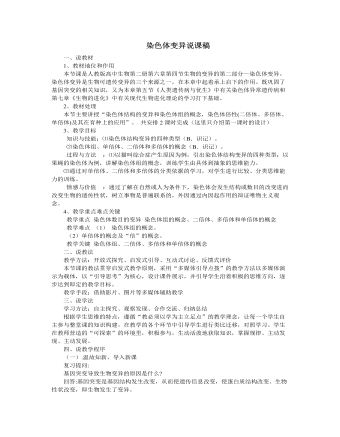
人教版高中生物必修2染色体变异说课稿
四、说教学程序(一).温故知新、导入新课复习提问:基因突变导致生物变异的原因是什么?回答:基因突变是基因结构发生改变,从而使遗传信息改变,使蛋白质结构改变、生物性状改变,即生物发生了变异。那么,基因是什么?它和染色体又有何关系?回答:基因是有遗传效应的DNA片断,染色体是DNA的载体,基因在染色体上呈线形排列。引出新知:对于一个生物体来说,正常情况下,其染色体的结构和数量都是稳定的。但在自然条件或人为因素的影响下,染色体的结构和数量均会发生改变,从而导致生物性状的改变,这就属于染色体变异。(二).把握重点、突破难点重点的把握:1、染色体结构的变异播放影片:猫叫综合征幼儿。让学生观察: 患儿哭声轻、音调高,很像猫叫。教师补充: 患儿的征状---两眼较低、耳位低下,存在着严重的智力障碍。阐述病因---染色体片段缺失

人教版高中英语必修1Journey Down the Mekong说课稿
2. let the Ss complete the forms paragraph by paragraph. Purpose here is to help Ss to get the habit of reading a passage as a whole, and pay attention to the organization of the text, as a result the Ss will fully understand the whole passage.3. ask Ss to retell the passage with the help of the key words in the form.Since the Ss in the class are in different levels, so I let them to fill in the blank to understand the meaning of the words and phrases better. ( That’s all for the while-reading. Now let’s move to the fifth step.)Step V: Post-reading (10mins) ---DiscussionIn this part students are asked to discuss in groups and list Wang Kun’s and Wang Wei’s attitudes about the trip. After that, Ss are encouraged to express their attitudes with the whole class. Collect their answers and don’t forget to praise them even if their answers may not be perfect.In this activity, discussion provides a vivid and active learning environment for Ss to communicate in English with newly learned language items. (Finally it comes to the homework.)StepⅥ: Homework (1min)1. Ss are required to read the text again after class and figure out the meaning of some complex sentences.2. Do the exercises on P19; This can help Ss to consolidate what they’ve learnt and make preparation for the next lessonPart4. Blackboard design.(说板书设计)On the top, there is the title of this lesson. On the left, there are main ideas for each paragraph. On the right, there are some new words and expressions.Unit 3 Travel journalJourney down the MekongMain idea of each para.:Para1: deciding to take a great bike trip along the Mekong river.Para2: Different attitudes between Wang kun and Wang wei.

人教版高中英语必修4Body Language说课稿4篇
Textbook: Senior English for China (Book 4), by Liu Daoyi Time Allotment: 1 period (40 minutes)Date: March 20, 2014Teaching aids: blackboard, Multi-media, Power Point, chalk I. Text Analysis (教材分析)This unit is about body language, and the text selected in the reading part demonstrates the difference and similarity of body language in many parts of the world. Through learning this passage, students are required to raise their awareness of using body language in different parts of the world. As body language is closely related to our daily life, it is easy to arouse students’ interest in learning this text. Reading skills and speaking training are designed around the text.II. Teaching Objectives (教学目标)By the end of the lesson, students will be able to:1. Language Skill Objective(语言技能目标): develop reading ability (skimming and scanning)as well as speaking ability.2. Cultural Knowledge Objective(文化知识目标): know about the cultural differences of using body language.3. Affective Objective(情感目标): increase students’ awareness of using body language correctly in different cultures. III.Teaching Focuses and Difficulties(教学重点和难点)1. Teaching Focuses(教学重点): the difference and similarity of body language in many parts of the world.2. Teaching Difficulties(教学难点): develop students’ reading abilities of skimming and scanning and ask the students to show their opinions with fluent English.

人教版高中英语必修2Computers说课稿3篇
一. 教材分析1. 本单元的中心话题是“计算机(Computers)”,内容涉及计算机的发展历史,计算机的应用等。本节课是该单元的第一课时,我将Warming up, Pre-reading and Comprehending这四部分整合为一节精读课。其中。Reading部分是题为WHO AM I?的文章,以第一人称的拟人手法介绍了计算机发长演变的历史和计算机在各个领域的应用,其主旨是表达计算机的发展变化之快以及在生活中用途之广。而Warming up部分以图片的形式展现了计算机的发展历程;Pre-reading中的问题和排序分别是为了预测语篇的内容和测试学生对计算机历史了解的情况;Comprehending则通过各项练习训练学生的阅读技能,从而加深对文章的理解。可见这几部分是一个有机的整体。2. 教学目标:1) 语言目标:重点词汇及短语:abacus, calculate, calculator, PC, laptop, PDA, robot, analytical, technological, universal, mathematical, artificial, intelligent, network, explore, in common, as a result.重点句子:a. My real father was Alan Turing, who in 1963 wrote a book to describe how computers could be made to work, and build a “universal machine” to solve any mathematical problem.

人教版高中英语必修2Cultural Relics说课稿2篇
Ⅲ. Analysis of the teaching material:The topic of this unit is cultural relics. Students are quite interested in topics about different cultures around the world. This is the second period of the whole unit. As a reading class, the passage mainly talks about the history of the amber room (how it was made, sent as a gift, lost and rebuilt).According to the new national curriculum, when teaching reading, much emphasis should be put on training the students’ reading skills.Ⅳ. Teaching objectives1. Language objectives:1) Students are required to master the key words and phrases occurred in the passage (e.g. amazing, decorate, belong, in return, less than etc.)2) Students are required to learn the attributive clause and acquire the sentence pattern.2. 1) Students are required to describe a certain thing by using the new sentence patterns.2) Students are required to master two kinds of reading skills—skimming and scanning, and learn to use them in their daily reading.3. 1) Students are required to know the history of the amber room.2) Students are required to appreciate cultural relics and understand the importance of protecting them.Ⅴ. Teaching important and difficult points1) the new words, phrases, and sentence pattern in the course of reading.2) Teaching difficult point: Help the students master two kinds of reading skills—skimmingand scanning and learn to apply them in daily use.Ⅵ. Teaching methods:Task-based method & Top-down model Ⅶ. Teaching aids: PPT, pictures, blackboard Ⅷ. Teaching procedure:

人教版高中英语必修4A taste of English Humor说课稿3篇
Then I would ask them to think of a funny English or Chinese and tell it to partners. While telling stories, they can use expressions and some acting to help make the story funny. 5 minutes would be given to do this.Those stories they told there will be the material for their writing. Soletting them tell it at first is helpful. And they can make a difference between telling a funny story and writing it down. Generally speaking, it is difficult forstudents to write well because they don’t know what to write and how to write. Asking them to tell their own stories at first can help them come up with what to write.After their telling, I would invite someone to share his/her story with all of us and I would write it down on the blackboard.This example story would be used as a sample to illustrate the format of funny story. Different from a story from teacher or textbook, a story from students can obviously become a interesting material to draw students’ attention.Then I would ask the whole class to put this story into several parts. It might be a little bit difficult for them. So I would ask them to find out whether all the sentences are necessary. After delete some sentences, there are 6 sentences left behind. Then they can easily put them into three parts. After interaction with students, I would teach them the right terms for each part and conclude the format of funny story.This step is the key and difficult point in my lesson. So I mainly usetask-based teaching method in this part and the task for students was divided into several stages. With the separated difficult level, students can find there are usually three parts in writing. They can also learn to write without the unnecessary parts in the process of analyzing. And then I wouldn’t rush to tell them the right terms to them directly. Instead, I would ask them to name them by their own. A confused mind is better for acquiring knowledge.While-writing:Then I would give students 7 minutes to write down this story, without other requirements.With all the preparations in pre-writing, students’ difficulties were cleared. So it would be much easier for them to write down the story within 7 minutes. There are no other requirements because students’ first writing is actually a drafting. It would be revise and edit several times later. Writing, as a skill

人教版高中英语必修3Canada-the true north说课稿4篇
Good afternoon, teachers, It’s my great pleasure to be here sharing my lesson with you.The content of my lesson is Senior English Book 3 Unit 5 Canada —— “The true North”.I’ll be ready to begin this lesson from five parts. Analysis of the teaching material,the teaching methods,the studying methods, the teaching procedure,and Blackboard design.First, let me talk about the teaching material.Part 1 Teaching Material:This unit is about the introduction of Canada. By studying of this unit,we’ll enable the students to learn the geography, population, main cities, and natural beauty, natural resources of Canada. Through the training of the unit, it also requires students to learn some Language skills such as the expressions of position and emotions.So it plays an important part in the English teaching in this book.After studying the teaching material and analyzing the rule of children’s growing of mind,I think the teaching aims are the followings:1.Knowledge objects:(1) make the students learn some new words and phrases(2) make the students understand the content of the lesson.2.Ability objects:(1)To develop the Ss’ abilities of listening, speaking, reading and writing. Especially reading and speaking ability.(2) learn to talk about the characters of Canada in English(3)To train the Ss’ ability of working in pairs.3.Emotion objects:(1)Enable students to understand the characters of Canada..(2)Stimulate Ss to work hard to make China stronger.Part 2 Teaching Methods:I think helping students learn to master new words and phrases and improve the students’ reading and speaking ability is import and the difficult.According to the analysis of the teaching material and the import points and the difficult points,I will use the following teaching methods : question-guiding approach; fast-reading and careful reading; multi-media teaching methods; discussion

人教版高中英语必修3Healthy Eating说课稿4篇
Language learning needs a context, which can help the learners to understand the language and then can product comprehensible output, so computer has the advantages to make the materials attractive.Part 3 Learning MethodsTask-based, self-dependent and cooperative learningPart 4 Teaching ProcedureStep One Lead-in“Interest is the best teacher.” Therefore, at the very beginning of the class, I should spark the students’ mind to focus on the centre topic “the band”. I’ll show some pictures of food to attract their attention and then bring some questions.Question:What kind of food they like?What should go into a good meal?The answers must relate to the diet. After this, the students will be eager to know something about a balance diet and this is the very time to naturally lead the class into Step 2Step 2 Reading for information: skimming and scanning In this step, I use Task-based Language Teaching method, which can give students a clear and specific purpose while skimming and scanning the context.Task 1 General ideaThe students will be asked to just glance at the title and the pictures of the passage, and then guess what they will read in the text. And they’ll be divided into groups of four to have a discussion.The purpose is to inspire the students to read actively, not passively. In addition, the task is to develop the students’ reading skill by making prediction and to encourage the students to express their thoughts in English and cooperate with each other.Task 2 Main idea of each paragraphCooperative learning can raise the students’ interest and create an atmosphere of achievement. Based on this theory, I divide the whole class into 4 groups to skim the whole text and get the main idea of each paragraph.

人教版高中英语必修4Working The Land说课稿3篇
Knowledge objectives:(1) to make Ss grasp the usage of words, expressions and sentence structures: statistics, struggle, thanks to, rid of, some patterns for persuasion, the “ing” form as subject and object;(2)to use learnt knowledge to persuade sb.Ability objectives:(1) to develop Ss’ reading skills(skimming, scanning, word guessing);(2) to improve Ss’ speaking, communicating and cooperating skills.Emotional objectives:to make Ss know the contribution of Yuan,and learn his spirit and his simple life time.Teaching important and difficult points:(1) some words, expressions and sentence structures mentioned above;(2)the content of the text;(3)training their reading and speaking skills.Teaching methods: CLT, TBLT,QT.Learning strategies: CLS, QLS, TBLS.Teaching procedures:Step 1 lead-in: (1) teacher plays a piece of recent news from CCTV about the harvest of the super hybrid rice, and ask students whether they know Yuan or not, and talk about him and his contribution.(2)Brain storm: let Ss describe Yuan in their minds including his appearance, his living condition and so on.Step 2 fast reading tasks:(1)teacher introduces Yuan and super hybrid rice(2)make Ss read the text as fast as possible with questions. Such as: what’s the general ideaof this passage? What’s Yuan’ dream? (skimming and scanning skill)Step 3 intensive reading tasks(1)let Ss read the text silently, find topic sentence of each paragraph and draw the difficult sentences and the knowledge what they don’t understand.(words guessing)(2)teacher and Ss talk about the important words, expressions and sentences together, and ask Ss to retell the content of the text.(summarizing and paraphrasing)(3)teacher summarize this part.(4) read again following the courseware.

人教版高中英语必修5Life in the Future说课稿5篇
Good afternoon, everyone. It’s my great pleasure to be here sharing my lesson with you. The content of my lesson is Senior English for China Book5 Unit 3 Life in the Future. I’ll be ready to begin this lesson from six parts: Analysis of the teaching material, Analysis of the students, Teaching aims and important and difficult points, Teaching methods and aids, Teaching procedures, and Blackboard design. First, let me talk about the teaching material.Part 1 Analysis of the Teaching Material:This unit is about what human beings’ life will be like in about one thousand years. By studying of this unit, we’ll Enable the students to know the changes in humans’ life and some new inventions bringing about the change and develop the interest in science. This lesson plays an important part in the English teaching in this unit. This is an important lesson in Book Five. From this lesson, it starts asking the Ss to grasp contents of each passage. Therefore, this lesson is in the important position of the teaching material. If the Ss can learn it well, it will be helpful to make the Ss learn the rest of this unit.Part 2 Analysis of the SsAs Senior2 Ss, they are at different levels of English fluency, some of them have lost interest in English. So during the lesson, I arrange a variety of activities to let all of them join in to attract their interest and let them be confident and taste the joy of success.

人教版高中英语必修5Making the news说课稿4篇
今天我们来介绍一下必修五第四单元的授课方式。这个单元的题目是Making the news。应该是学生比较感兴趣的话题,学生往往对新闻工作充满好奇,所以我们可以利用这个机会多设计一些师生互动和学生互动,来激发起学习的积极性,提高学习效率。同时我们可以利用这个单元不仅帮助学生掌握语言知识,培养语言能力,同时让其了解新闻工作的重要性,培养起社会智能感。这个单元分为六个课时,它的教学目标是这样的:语言目标是掌握词汇表中的常用单词和短语,掌握倒装句的一些基本用法。 技能目标是能初步掌握约会的基本句型并在真实的场景下正确运用。新闻报道类文章的写作技能。采访的基本规范和沟通技能。情感目标是对新闻报道的客观性和真实性有更好的理解。对新闻记者的职业有更深入的了解,并能体会其工作的重要性。下面我们来介绍一下第一课时的授课方式,第一课的教学目标是这样的第一课时的教学目标语言目标:单词:Occupation, journalist, editor, photographer, curious, personality, enthusiasm
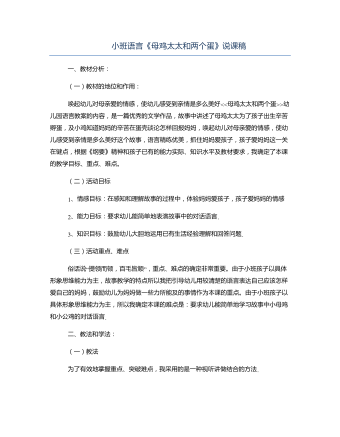
小班语言《母鸡太太和两个蛋》说课稿
唤起幼儿对母亲爱的情感,使幼儿感受到亲情是多么美好<<母鸡太太和两个蛋>>幼儿园语言教案的内容,是一篇优秀的文学作品,故事中讲述了母鸡太太为了孩子出生辛苦孵蛋,及小鸡知道妈妈的辛苦在蛋壳谈论怎样回报妈妈,唤起幼儿对母亲爱的情感,使幼儿感受到亲情是多么美好这个故事,语言精练优美,抓住妈妈爱孩子,孩子爱妈妈这一关在键点,根据《纲要》精神和孩子已有的能力实际、知识水平及教材要求,我确定了本课的教学目标、重点、难点。1、情感目标:在感知和理解故事的过程中,体验妈妈爱孩子,孩子爱妈妈的情感2、能力目标:要求幼儿能简单地表演故事中的对话语言.3、知识目标:鼓励幼儿大胆地运用已有生活经验理解和回答问题.

小班美术《蔬菜印画一一美丽的花衣服》说课稿
《蔬菜印画》是选自华东师大建构教材中班的一个活动,但根据小班幼儿的年龄特点,我在制定目标和过程中做了相应改动。孩子的天性就喜欢写写画画,他们在写写画画中提高了自己的动手能力,表达了自己的天真想法;所以,作为教师的我们要提供给孩子充分的表现空间,运用多种艺术表现手法,来丰富幼儿的艺术活动。活动目标是教育教学活动的起点和归宿,对活动起着导向的作用。我觉得在制定目标时要遵循“紧凑、精练、突出教育性”的原则,依据教材内容与幼儿情况的剖析,吸取人本主义的理念,从满足幼儿“认知、情感、能力”的角度出发,结合《纲要》精神以及科学、艺术领域的总目标,我制定了以下几点目标:1.学会用蔬菜的横截面,蘸上颜料进行拓印,锻炼幼儿手眼的协调能力。2.通过对红、黄、蓝三种颜色的认识,培养对色彩的兴趣并体验蔬菜印画的乐趣。重点:用蔬菜的横截面礁上水粉颜料进行拓印。难点::要求均匀蘸色,不混色,并找对蔬菜和颜色的“家”。
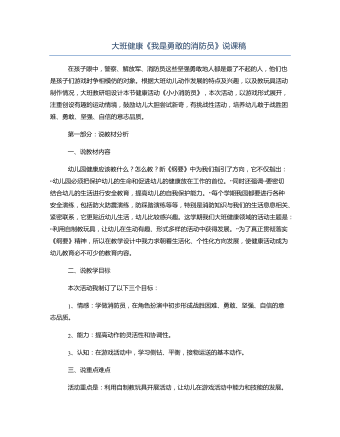
大班健康《我是勇敢的消防员》说课稿
幼儿园健康应该教什么?怎么教?新《纲要》中为我们指引了方向,它不仅指出:“幼儿园必须把保护幼儿的生命和促进幼儿的健康放在工作的首位。”同时还强调“要密切结合幼儿的生活进行安全教育,提高幼儿的自我保护能力。”每个学期我园都要进行各种安全演练,包括防火防震演练,防踩踏演练等等,特别是消防知识与我们的生活息息相关、紧密联系,它更贴近幼儿生活,幼儿比较感兴趣。这学期我们大班健康领域的活动主题是:“利用自制教玩具,让幼儿在生动有趣、形式多样的活动中获得发展。”为了真正贯彻落实《纲要》精神,所以在教学设计中我力求朝着生活化、个性化方向发展,使健康活动成为幼儿教育必不可少的教育内容。
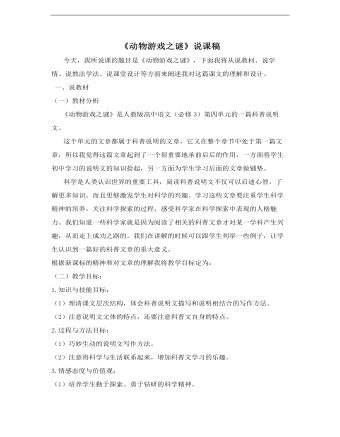
高中语文人教版必修三《动物游戏之谜》说课稿
科学是人类认识世界的重要工具,阅读科普说明文不仅可以启迪心智,了解更多知识。而且更够激发学生对科学的兴趣。学习这些文章要注重学生科学精神的培养,关注科学探索的过程,感受科学家在科学探索中表现的人格魅力。我们知道一些科学家就是因为阅读了相关的科普文章才对某一学科产生兴趣,从而走上成功之路的。我们在讲解的时候可以跟学生列举一些例子,让学生认识到一篇好的科普文章的重大意义。
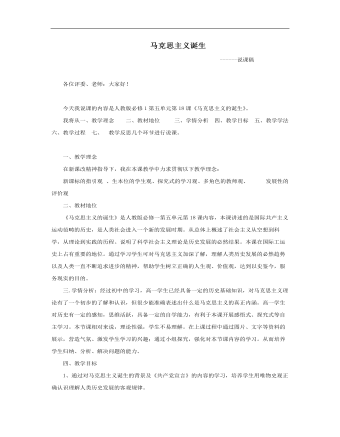
高中历史人教版必修一《马克思主义的诞生》说课稿
一、教学理念在新课改精神指导下,我在本课教学中力求贯彻以下教学理念:新课标的指引观 、生本位的学生观、探究式的学习观、多角色的教师观、 发展性的评价观二、教材地位《马克思主义的诞生》是人教版必修一第五单元第18课内容,本课讲述的是国际共产主义运动范畴的历史,是人类社会进入一个新的发展时期。从总体上概述了社会主义从空想到科学,从理论到实践的历程。说明了科学社会主义理论是历史发展的必然结果。本课在国际工运史上占有重要的地位。通过学习学生可对马克思主义加深了解,理解人类历史发展的必然趋势以及人类一直不断追求进步的精神,帮助学生树立正确的人生观、价值观,达到以史鉴今,服务现实的目的。
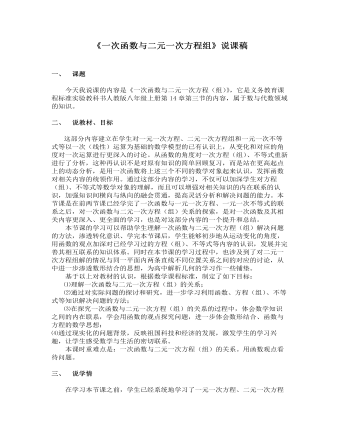
《一次函数与二元一次方程组》说课稿
一、 说教材、目标这部分内容建立在学生对一元一次方程、二元一次方程组和一元一次不等式等以一次(线性)运算为基础的数学模型的已有认识上,从变化和对应的角度对一次运算进行更深入的讨论。从函数的角度对一次方程(组)、不等式重新进行了分析,这种再认识不是对原有知识的简单回顾复习,而是站在更高起点上的动态分析,是用一次函数将上述三个不同的数学对象起来认识,发挥函数对相关内容的统领作用。通过这部分内容的学习,不仅可以加深学生对方程(组)、不等式等数学对象的理解,而且可以增强对相关知识的内在联系的认识,加强知识间横向与纵向的融会贯通,提高灵活分析和解决问题的能力。本节课是在前两节课已经学完了一次函数与一元一次方程、一元一次不等式的联系之后,对一次函数与二元一次方程(组)关系的探索,是对一次函数及其相关内容更深入、更全面的学习,也是对这部分内容的一个提升和总结。
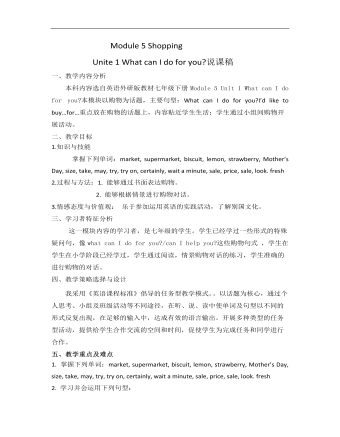
初中英语外研版七年级下册《Module 5 Shopping》说课稿
二、教学目标1.知识与技能掌握下列单词:market, supermarket,biscuit, lemon, strawberry, Mother’s Day, size, take, may, try, try on,certainly, wait a minute, sale, price, sale, look. fresh2.过程与方法:1. 能够通过书面表达购物。2. 能够根据情景进行购物对话。3.情感态度与价值观:乐于参加运用英语的实践活动,了解别国文化。
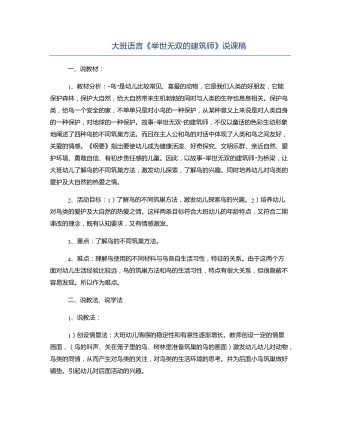
大班语言《举世无双的建筑师》说课稿
2、活动目标:1)了解鸟的不同筑巢方法,激发幼儿探索鸟的兴趣。2)培养幼儿对鸟类的爱护及大自然的热爱之情。这样两条目标符合大班幼儿的年龄特点,又符合二期课改的理念,既有认知要求,又有情感激发。3、重点:了解鸟的不同筑巢方法。4、难点:理解鸟使用的不同材料与鸟各自生活习性,特征的关系。由于这两个方面对幼儿生活经验比较远,鸟的筑巢方法和鸟的生活习性,特点有很大关系,但很隐蔽不容易发现。所以作为难点。二、说教法、说学法1、说教法:1)创设情景法:大班幼儿情感的稳定性和有意性逐渐增长。教师创设一定的情景画面,(鸟的叫声、关在笼子里的鸟、树林里准备筑巢的鸟的画面)激发幼儿幼儿对动物,鸟类的同情,从而产生对鸟类的关注,对鸟类的生活环境的思考。并为后面小鸟筑巢做好铺垫。引起幼儿对后面活动的兴趣。2)动手操作法:大班幼儿随着年龄的增长,他们的思维已由直觉行动思维过渡到具体形象思维。他们喜欢听故事,喜欢动手操作。教师准备树枝、柳絮、有小树洞的树根、泥浆土。以及记录卡和笔。让孩子在了解这几种鸟的特点后通过摸摸、比比、做做等方法探索鸟的不同筑巢方法,并做记录。充分调动起幼儿学习的主动性和积极性。3)符号记录法:大班幼儿表现表达的欲望与能力逐渐增强,教师要抓住时机利用任何机会引导幼儿用多种方法表达。符号记录也是幼儿的一种表达方法。教师让幼儿自己操作后记录。提高幼儿记录的能力。4)交流讨论法:操作以后的交流讨论,是幼儿对自己探索后的另外一种表达形式。在幼儿的交流讨论中教师通过观察、聆听了解幼儿的思维方法,经验积累的程度,适时适度地帮幼儿归纳、总结、提升。并推动活动朝更深层次发展。5)阅读法:大班幼儿的年龄特点中指出:幼儿阅读兴趣明显提高,能较长时间地看书,对内容的理解能力较强。而且开始对文字感性趣。因此,请幼儿边翻阅图书边听老师讲故事,不但帮助幼儿养成良好的阅读方法和习惯,并从阅读的故事中寻找,验证自己的答案。这也是养成良好学习方法的一个方面。
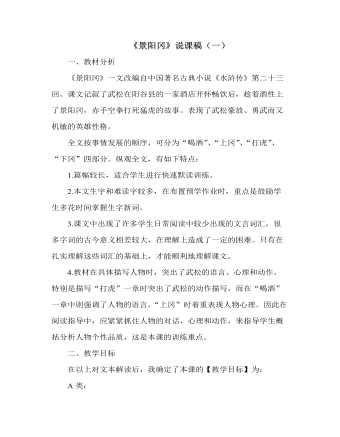
部编人教版五年级下册《景阳冈》说课稿(一)
全文按事情发展的顺序,可分为“喝酒”、“上冈”、“打虎”、“下冈”四部分。纵观全文,有如下特点:1.篇幅较长,适合学生进行快速默读训练。2.本文生字和难读字较多,在布置预学作业时,重点是鼓励学生多花时间掌握生字新词。3.课文中出现了许多学生日常阅读中较少出现的文言词汇,很多字词的古今意义相差较大,在理解上造成了一定的困难。只有在扎实理解这些词汇的基础上,才能顺利地理解课文。4.教材在具体描写人物时,突出了武松的语言、心理和动作。特别是描写“打虎”一章时突出了武松的动作描写,而在“喝酒”一章中则强调了人物的语言。“上冈”时着重表现人物心理。因此在阅读指导中,应紧紧抓住人物的对话,心理和动作,来指导学生概括分析人物个性品质,这是本课的训练重点。

